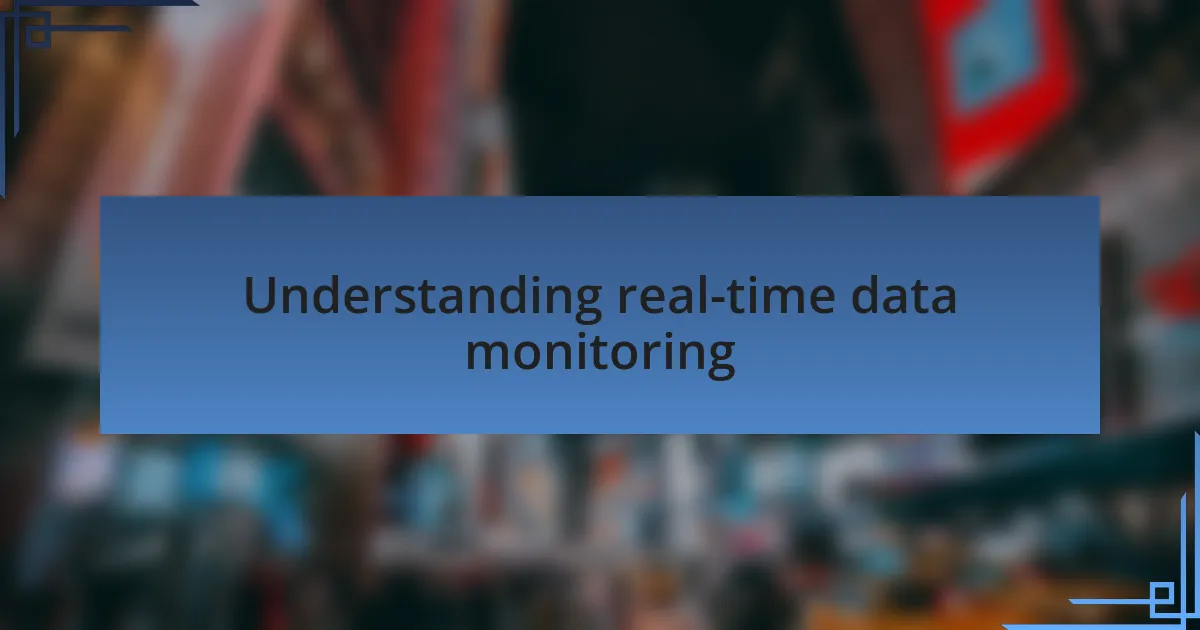Key takeaways:
- Real-time data monitoring enables immediate, actionable insights, enhancing customer engagement and tailoring experiences.
- Tools like Google Analytics, Databox, and Hotjar provide powerful data tracking and visualization to inform marketing strategies.
- Integrating qualitative and quantitative data along with regularly updating analysis methods can significantly improve decision-making.
- Choosing user-friendly tools and fostering a data-driven culture enhances collaboration and understanding across teams.

Understanding real-time data monitoring
Real-time data monitoring is a game changer in our fast-paced digital world. I remember the first time I used real-time analytics for a client’s campaign; it felt exhilarating to see how immediate actions could influence customer engagement in mere seconds. Do you realize how powerful it is to make decisions based on live data, rather than waiting for a weekly report?
Understanding this concept goes beyond just metrics; it’s about transforming insights into action. I often find myself thinking about how quickly trends can shift, and with real-time monitoring, you can pivot strategies on the fly. Isn’t it fascinating to think you can adjust your marketing campaigns based on what is happening right at that moment?
What truly sets real-time data monitoring apart is its potential to enhance customer experience. I recall a project where instant feedback led to immediate changes in messaging that resonated with the audience. Don’t you want to be the first to know what your customers are thinking? By keeping an eye on real-time data, you’re not just reacting; you’re anticipating needs and crafting tailored experiences.

Key tools for data monitoring
When it comes to data monitoring, tools like Google Analytics stand out. I remember integrating Google Analytics into a client’s website; the real-time tracking feature opened my eyes to user behaviors I’d never noticed before. Can you imagine how empowering it was to see what visitors were doing right away?
Another key tool is Databox, which I’ve found incredibly useful for aggregating data from multiple sources. I once set up a dashboard that pulled in metrics from social media, website traffic, and email campaigns simultaneously. It felt like having a control center at my fingertips; I could compare performance across channels and adjust strategies in real-time. Aren’t you curious about how such visuals could streamline your decision-making processes?
Lastly, I can’t overlook the power of Hotjar for understanding user interactions. I vividly recall a time when heatmaps revealed that users were clicking on parts of a page that weren’t even linked. It was a light bulb moment for our design choices! How often do we think we know what users want, only to find out there’s a disconnect? Tools like Hotjar help bridge that gap, making our insights that much richer.

Best practices for data analysis
Effective data analysis requires a clear strategy. In my experience, I’ve found that defining specific goals before diving into data makes a world of difference. I once led a campaign where we aimed to boost user engagement by 25%. By focusing solely on relevant metrics, we zeroed in on what truly mattered, which ultimately led to our success. How do you determine your focus points when sifting through countless data sets?
Another best practice is to integrate qualitative insights with quantitative data. I remember collaborating with a client’s team to analyze survey responses alongside our analytics. This combination provided a fuller picture of user motivations and behaviors, illuminating trends that numbers alone wouldn’t reveal. Have you ever thought about how empathy and context can enhance your data-driven decisions?
Regularly revisiting and updating your data analysis processes is also crucial. I’ve encountered scenarios where outdated methods led to missed opportunities. For instance, after recognizing shifts in user behavior during a seasonal campaign, we adapted our analytics approach and fine-tuned our marketing strategies. It’s fascinating how a small tweak can rejuvenate efforts, isn’t it? Always be open to evolving how you analyze data.

How to implement data monitoring
To effectively implement data monitoring, start by choosing the right tools that align with your business goals. I recall a project where we opted for a user-friendly dashboard that allowed our entire team to visualize key metrics at a glance. This simple change fostered a shared understanding across departments, and I realized how vital it is to select tools that resonate with the users, not just the tech team.
Next, establish a routine for data checks that suit your operation. In one instance, I set up a weekly review process for campaign performance, which ensured we stayed on track and could adapt swiftly. Have you considered how a consistent schedule can help you catch trends early rather than reacting too late?
Finally, foster a data-driven culture within your organization. I remember facilitating workshops where we explored both the technical aspects and the narratives behind the numbers. This approach made data come alive, and it made me proud to see my colleagues engage with insights that once felt intimidating. Isn’t it amazing how sharing knowledge can transform apprehension into excitement?